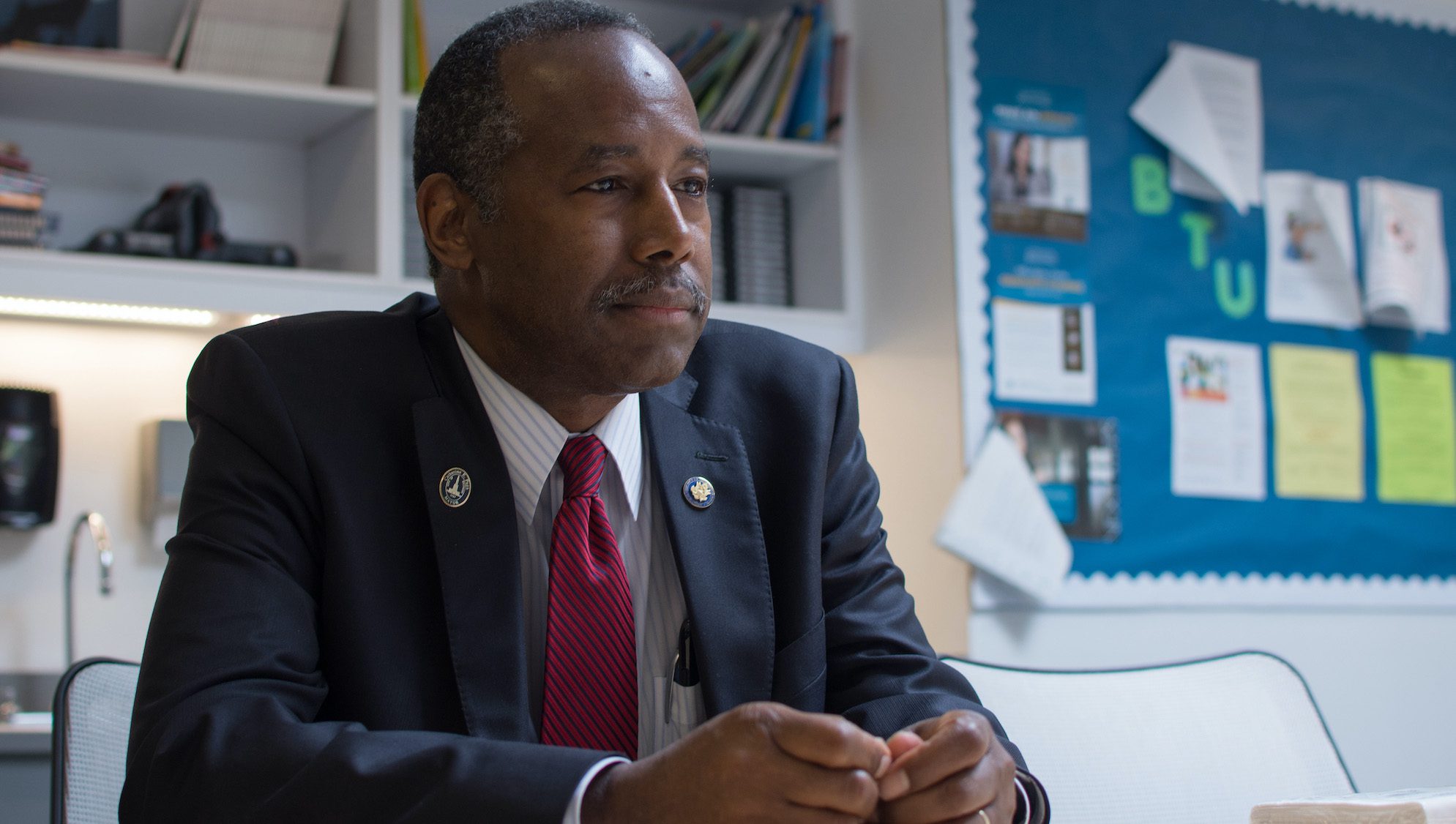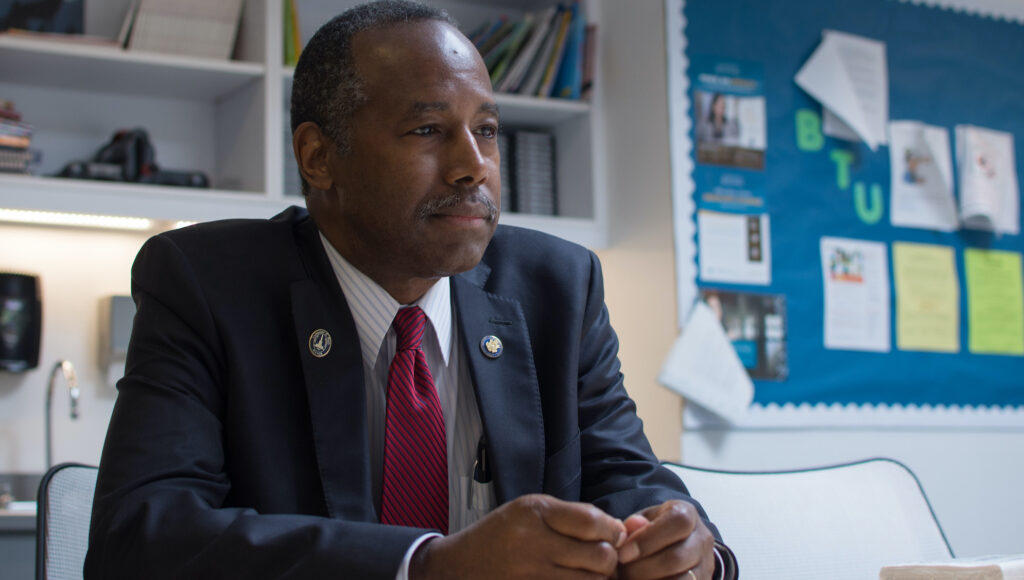
Baltimore Sun / Contributor/Getty Images
When Dr. Ben Carson took the helm of the nation’s top housing agency, the country was in the early throes of an affordable housing crisis. Four years, one pandemic, and a recession later, the secretary of the U.S. Department of Housing and Urban Development’s tenure is about to come to an end.
Now, as Carson’s perceived accomplishments and failures are dissected, will history look kindly upon his legacy at HUD?
Many criticized the renowned neurosurgeon’s lack of housing policy experience when he took the Cabinet position. Initially, Carson seemed to agree. In late 2016, his spokesman told reporters the last thing the former presidential candidate would want was to take a position that could hurt Donald Trump‘s presidency given his lack of government experience.
Clearly, he changed his mind. His supporters pointed to his childhood raised by a single mother in Detroit, living in public housing for a time, as providing him with real-world qualifications for the job.
Under Carson, opportunity zones were created to spur development in struggling communities and a President Barack Obama–era rule to racially diversify the suburbs was axed. Carson also crusaded against dangerous lead paint in housing.
On Thursday, the agency unveiled a new tool, called Find Shelter, to help folks in need locate shelter, clothing, food pantries, and health clinics.
Yet, the affordable housing shortage worsened under Carson’s watch, becoming a dire problem as home prices surged to new heights even as the economy struggled under the weight of the COVID-19 pandemic. And HUD’s budget was cut from $49.3 billion in 2016 to a proposed $47.9 billion this year.
“Many of us will say we wish there had been more of a national housing strategy, because we’re undergoing a national affordable housing crisis,” says Adrianne Todman, CEO of the National Association of Housing and Redevelopment Officials. The trade organization represents about 20,000 public housing and redevelopment officials. “[But] we were pleased that the department took some steps at what were some barriers to building affordable housing.”
Some described Caron’s years at HUD as maintaining the status quo.
However, it’s not fair to blame Carson for not overseeing many sweeping changes at the agency, says Tony Campbell, an adjunct political science professor at Towson University.
“I don’t think there was much accomplished because the president wasn’t interested in policy one way or another at HUD,” says Campbell. He ran Carson’s failed presidential campaign in Maryland and ran for the U.S. Senate on the Republican ticket in 2018. He lost to his Democratic opponent. “[The president and his team] weren’t interested in getting into the weeds on domestic policy.”
During his tenure, Carson snagged headlines for planning to spend $31,000 on dining room furniture for his office, which included $1,000 side chairs. But the purchases never went through and he was later cleared of wrongdoing by the agency’s internal watchdog.
Beyond that incident, his time at HUD was relatively scandal-free. He also avoided the public ire of Trump.
After leaving HUD, Carson reportedly told confidants that he’d like to start a think tank after HUD, according to Axios.
America’s affordable housing crisis has gotten worse
Over the past few years, home prices across the nation have risen to new heights. Meanwhile, the supply of affordably priced homes for sale along with rental properties has dropped sharply. The pandemic made everything worse.
“The need for additional affordable housing is desperate,” says Chad Williams, executive director and CEO at the Southern Nevada Regional Housing Authority. The authority oversees Las Vegas and other Nevada cities.
Critics took aim at Carson not constructing more affordable housing or providing additional Section 8 vouchers for families in desperate need of rental housing. About a quarter of the poorest households eligible for the federal vouchers don’t receive them because there aren’t enough to go around.
Carson continued an Obama-era program to encourage the private sector to invest in bonds, which raised money to maintain and renovate the country’s public housing stock.
Todman, of the National Association of Housing and Redevelopment Officials, gave Carson an F for not providing enough funding to put up new affordable housing. But she didn’t place all of the blame at his door.
“The pandemic really exacerbated the housing crisis,” says Todman. “It’s not HUD’s fault that there’s a rental crisis caused by the pandemic.”
Mortgage forbearance gives struggling homeowners a lifeline
As the coronavirus pandemic shut down much of the nation in the spring, millions of people lost their jobs. Some of them were homeowners who abruptly were unable to continue paying their mortgages.
In response, HUD temporarily suspended foreclosures in March for all single-family-home owners affected by COVID-19 with Fannie Mae and Freddie Mac loans. Homeowners with the government-backed loans were eligible for up to 12 months of mortgage forbearance where they could pause their payments. At the end of that period, their loans can be adjusted and they may be able to have their missed payments tacked onto the ends of their loans.
About half of all residential mortgages, roughly 28 million, are Fannie and Freddie loans. Many other banks that issued nongovernment-backed loans followed HUD’s example.
While the future of the program is still unknown, many believe the forbearance warded off another foreclosure crisis.
“If you did not provide forbearance and some help, a lot of people were going to lose their homes through no fault of their own,” says John Weicher. He is the director of the Center for Housing and Financial Markets at the Hudson Institute, a conservative-leaning think tank in Washington, DC. The forbearance has “been very helpful and very sensible.”
The eviction moratorium that has kept numerous renters in their homes came out of the Centers for Disease Control and Prevention and not HUD.
Opportunity Zones receive mixed reviews
In 2017, the administration created so-called Opportunity Zones to spur investment in struggling communities. It provides investors with tax breaks to pour money into these areas to revitalize them. In return, the investors get tax breaks that allow them to defer paying capital gains taxes or pay discounted rates on some of the money they’ve made.
Reviews of the zones have often fallen along partisan lines. Republicans have favored the tax breaks, while Democrats believe those living in these areas aren’t benefiting enough from the program.
“There are always a lot of detractors when wealth is getting tax offsets,” says Robert Moss, national director of government affairs at the accounting firm CohnReznick. The accounting firm consults on low-income tax credits used to build public housing. “[But] Opportunity Zones are getting things done, like bringing in businesses to struggling communities.”
This also generates new jobs for locals to fill, he says.
But others have complained the boundaries of the zones were drawn to help the investors more than the communities they are supposed to serve.
In Las Vegas, some of the zones abut popular, more economically sound areas while bypassing other areas in need, charges Williams, whose housing authority oversees Las Vegas.
“Who really benefits from these Opportunity Zones? Usually it’s a big-box or other mainstream business,” says Michela Zonta. She’s a senior housing policy analyst at the Center for American Progress, a left-leaning think tank. “Anytime there’s some form of community development that leads to an increase in land values, low-income residents risk being displaced from eviction or not being able to afford their places.”
Yet others praised the initiative as “worthwhile” and supported the locations of the zones.
“They’ve identified the right areas to be covered,” says the Hudson Institute’s Weicher.
Obama-era rule to diversify suburbs is axed
Trump and HUD took some flak for ending an Obama-era rule designed to racially diversify and create more affordable housing in the suburbs. The president was criticized for cutting the Affirmatively Furthering Fair Housing regulation late last year as way to appeal to suburban women before the election.
The rule was designed to force cities receiving federal housing money to assess and then address local housing discrimination. The goal was to see zoning changes to allow more affordable housing, such as condo and apartment buildings and smaller, single-family homes, to go up in the suburbs.
Carson “didn’t really push for reforms or addressing racial segregation and the need for affordable housing,” says the Center for American Progress’ Zonta. “That rule addressed some of the problems of decades of housing discrimination against people of color—and the lack of access to decent and affordable housing and better neighborhoods.”
EnVision Centers get off to a rocky start
Building on his goal of encouraging self-sufficiency to help people rise out of poverty, the secretary hoped to create more than 3,000 EnVision Centers across the nation.
The centers cater to struggling Americans, particularly young people. They consolidate many existing services by housing them under one roof. Carson wanted to have a one-stop shop where people could access educational and mentorship, job training, and health care services among others.
About two years ago, HUD approached the Southern Nevada Regional Housing Authority about setting them up in public housing, says the housing authority’s Williams. HUD “pressured” the authority to provide space and staff for them—but didn’t offer any funding to pay for the real estate or the employees needed to run them.
Since the services that would be housed in the EnVision Centers were already being offered and no money was being offered, the housing authority declined to create them.
That could explain why the centers haven’t caught on. So far, the agency has just under 100 of them instead of the 3,000 Carson had wanted, according to HUD.
Jeopardizing housing for undocumented immigrants and homeless, transgender Americans
The HUD secretary has also pushed to allow government-funded homeless shelters to refuse to put transgender people in housing based on their gender identities. That means a shelter could refuse to place a female-identified individual in a women’s shelter.
However, the rule isn’t expected to be formalized until April—after Joe Biden becomes the nation’s 46th president. His administration isn’t expected to turn this into law.
“They should have access to homeless shelters just like everyone else,” says Zonta.
In addition, HUD proposed requiring all those living in public housing or receiving federal housing vouchers to be U.S. citizens. This would have imperiled families where some members were in this country legally and others were not.
However, the law was never implemented.
“It goes against the purpose of the office, which is to ensure that everyone has access to affordable and decent housing,” says Zonta.
The post The Ben Carson Years at HUD: Did He Make a Difference? appeared first on Real Estate News & Insights | realtor.com®.
